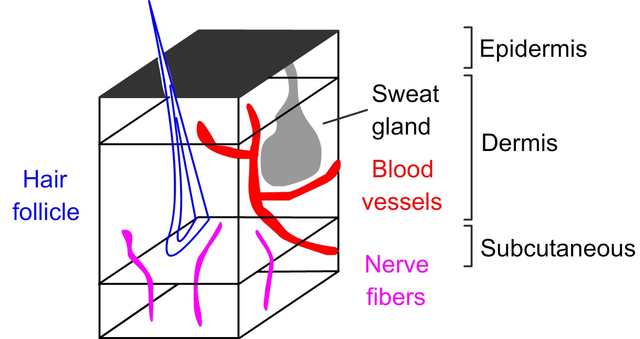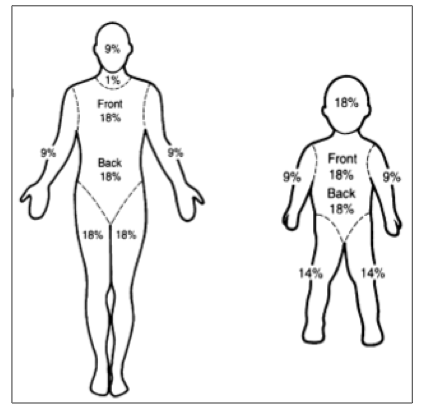Burn Wounds
Burn Wounds
American Burn Association Classification (2009)
Superficial: EPIDERMIS depth only; painful
Partial-Thickness: Involves dermis
- Superficial
- EPIDERMIS + SHALLOW DERMIS
- Moist, blistering; skin blanches, very painful
- Heals within 3 weeks
- Deep
- EPIDERMIS + DEEP DERMIS
- Looks between superficial partial-thickness and 3rd degree burn
- May need skin graft
- Heals in >3 weeks
Full-Thickness:
- EPIDERMIS + ENTIRE DERMIS
- Dark brown, charred, skin does not blanch
- Site insensate because burned nerve fibers
- Needs skin graft

Total body surface area (TBSA)
- Rule of 9’s
- Patient’s palm and fingers = 1% TBSA
- In calculating TBSA % burn, do not include 1st degree burns

Burn unit referral
- Partial thickness >10% TBSA
- Burns of face, hands, feet, genitalia, perineum, major joints
- Full thickness burn
- Electrical or chemical burn
- Inhalational injury
- Patient with co-morbidities
- Special considerations: Social, emotional, or long-term rehab intervention
Fluid resuscitation = 4 cc/kg/% TBSA of Lactated Ringers over 24 hrs with half given in first 8 hrs
- Titrate to urine output
| Age | Target urine output |
|---|---|
| Adults | 30-50 cc/hr |
| Age > 2 yr | 0.5-1 cc/kg/hr |
| Age < 2 yr | 1-2 cc/kg/hr |
- Start if >20% TBSA involvement
Burn Management
Minor burns
- Tetanus update
- Pain medications
- Debride dead skin, +/- unroof blisters >2 cm diameter
- Apply topical antimicrobial/dressing
- 24 hr follow-up
Large burns
- Apply topical antimicrobial agent such as bacitracin, neomycin, mupirocin, or honey. Membrane-based dressings can be used alternatively.
Practice Change: Silver sulfadiazine has fallen out favor for burn prophylaxis in partial-thickness burns. May slow wound healing, increases frequency of dressing changes, and more painful
What is high voltage injury? >1000 volts